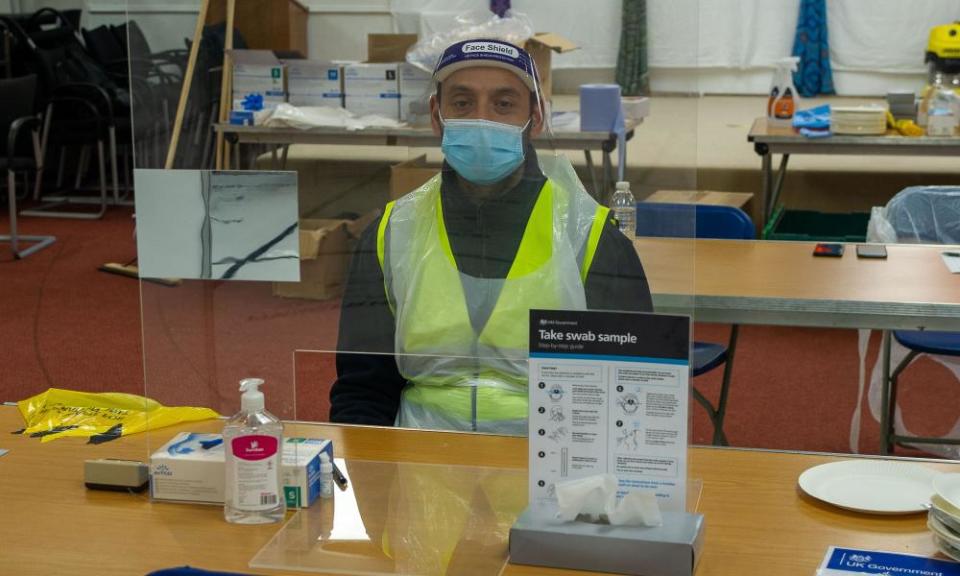Data on Covid infections in England suggests cautious approach best

A quick glance at the government’s coronavirus dashboard might be fuel for optimism. But new data suggests the picture may not be so rosy.
According to the dashboard, the number of people testing positive for Covid is falling: 37,892 positive tests were reported on Thursday, compared with 62,322 on 6 January. Cases by specimen date show similar trends.
A summary of rebuttals offered by the Anti-Virus website to selected claims made by sceptics – detailed in full on the site.
Claim: The infection fatality rate (IFR) is very low – 99.5% of people who get it survive
Response: The 0.5% figure has been challenged by significantly higher recent estimates, and it understates how lethal Covid is to older people who get it. The IFR is being kept low by lockdown – and if the virus were allowed to spread, the death rate would be higher because there wouldn't be enough space in hospitals to treat those who need it.
Claim: 91% of Covid ‘cases’ are false positives. This is a ‘casedemic’
Response: This theory is based on a statistical misunderstanding, and since during the summer (when Covid cases were low) only 0.3% of tests were showing positive results, it cannot be that a much greater proportion of positive tests are now “false”. In any case, the huge rises in hospitalisations and deaths disprove the idea that people aren’t really getting sick.
Claim: There are no excess deaths
Response: The ONS recently estimated 14% more deaths in the previous year than the baseline from the previous five years – and that happened even though in the latter part of the year, deaths from causes other than coronavirus actually fell.
Claim: Lockdowns cause more deaths than they prevent
Response: This contradicts all the evidence that virtually all of the excess deaths we have seen have been attributable to Covid. Suicide rates have not risen, and violence may have fallen. Pressure on the NHS is being increased by coronavirus, not lockdown, and would only grow if restrictions were lifted.
Claim: Danish study shows masks don’t stop the spread
Response: The study was only testing protection for the wearer, not others in the vicinity. Problems with its design were pointed out before it was conducted, and there is lots of evidence from around the world that mask-wearing is associated with a lower rate of increase in the spread of the virus.
The data reflects people who have taken a test, generally after having developed symptoms. However there are also large variations in test numbers, which could affect trends.
To take the latter into account, it is possible to look at the percentage of people who have taken a test that get a positive result. According to the weekly report into pillar 2 (community) testing data from Public Health England, there was a sharp decline in this positivity rate over the first two weeks of January.
However, an analysis of the data by the Independent Sage group of experts suggests the decline in positivity rate slowed down or even plateaued in many regions of England towards the end of that period.
To get a clearer idea of what is happening with Covid infections, a number of research teams carry out population surveys whereby randomly selected people in the community are swabbed for coronavirus – this picks up both those with symptoms and those without, and is not affected by biases in testing.
default
This data suggests the overall picture is a little less cheering than first thought.
According to the latest data release from the population survey run by the Office for National Statistics, covering the period 3 to 16 January, there has been a decline in the percentage of people testing positive in England – but this is not as dramatic at the PHE figures might suggest.
Indeed some regions, including the south-west, have actually shown a rise in infections since the start of the year while others such as the north-west, north-east and West Midlands have levelled off.
Even in London, the east Midlands and Yorkshire and the Humber, where positivity rates have dropped, modelling by the ONS team appears to tentatively suggest the decline may have recently slowed, although more time needs to pass to be sure. “Caution should be taken in overinterpreting any small movements in the latest trend,” the ONS team warns.
The latest findings from another population survey, known as React-1, which cover the period from 6 to 15 January, have also prompted concern. These results suggest that, while new infections might previously have fallen they may now be flattening off at a national level, or even showing signs of a slight rise.
While the signs all point to the peak of infections having passed, for England at least, the outlook warrants optimism tinged with caution.
A plateau at present would be of deep concern, with hospitals under severe pressure and deaths at record highs – although it is hoped that the vaccination programme will eventually help these to fall. It would also raise the question of what new restrictions might be needed, and for how long.
However it may yet be that cases, and positivity rate, will proceed to decline. For now, it is seems, only time will tell.

 Yahoo Finance
Yahoo Finance 